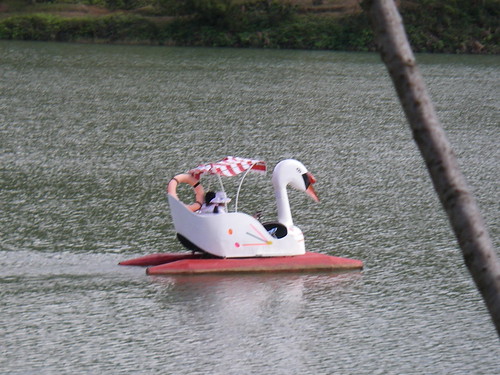 So what does a mountain resort for Vietnamese newlyweds look like? Well, I'll tell you. It's got a man-made lake with swan-shaped paddle-boats, a theme park named the Valley of Love filled with pirated Disney characters contorted into heart shapes, a large Buddha with a neon halo, a "crazy house" that looks like it was designed by a manic Gaudi and a bunch of motorcycle guys named the Easy Riders hawking wonderful motorcycle tours of the central highlands. So, you may wonder which of these options did we investigate? Sadly, the motorcycle trip was a bit spendy, but the Valley of Love and the Crazy House were priced just right.
So what does a mountain resort for Vietnamese newlyweds look like? Well, I'll tell you. It's got a man-made lake with swan-shaped paddle-boats, a theme park named the Valley of Love filled with pirated Disney characters contorted into heart shapes, a large Buddha with a neon halo, a "crazy house" that looks like it was designed by a manic Gaudi and a bunch of motorcycle guys named the Easy Riders hawking wonderful motorcycle tours of the central highlands. So, you may wonder which of these options did we investigate? Sadly, the motorcycle trip was a bit spendy, but the Valley of Love and the Crazy House were priced just right.
In order to make a day of the above mentioned sites, we rented bikes and attempted to follow a poorly rendered map up and down some pretty steep hills. Eventually, we found the Valley of Love, which the locals call "the Valley of Shops" and paid our 80cents admission. To say that the place is a tad tacky would be under-selling the experience. Muzaked versions of love songs are piped everywhere in the park, there are paths around a second man made lake with tons of photo-ops for newly engaged couples as well as picnic huts with lockable doors. You read that right. The Valley of Love has private "picnic" huts. From sweet to seedy in a few steps. After a few hours of strolling around and avoiding both the shops and the huts, we decided to check out the Crazy House.
The house itself was designed by a Moscow-educated architect who is the daughter of Vietnam's former President, Truong Chinh. While it is still (and maybe forever) under construction, what exists now is series of cave-like rooms connected by staircases that seem extruded from some cement machine. Each of the rooms (which are rent-able) has an animal theme. For instance, one room has a giant kangaroo with glowing read eyes whose pouch doubles as a stove. Here is where words fail. There is little in the world more fanciful and terrifying than a red-eyed roo with fire in its pouch. I think that the pictures of the place are the closest we can get to conveying the gestalt of the place.
After the long day of bike-riding, we were on our way back to our guesthouse when we ran into one of the Easy Riders named Peter who tried his best earlier in the day to sell us on a tour. Since we were going to be leaving the next day and were therefore unsaleable, Peter's marketing personality dropped and he invited us to hang out with his friends and have a beer. We spent the next few hours learning Vietnamese useful and not-so-useful phrases and talking about history, politics and the differences between America and Vietnam, and between North Vietnam and South Vietnam. One resounding lesson (apart from the fascinating discussion of post-war Vietnam) that we took away from the experience courtesy of Peter's friend Bin was that if you are buying a gift for your your Vietnamese friend, do not buy a $120 pair of shoes in the States. He probably already has them and they cost him $8 here.
-d
Sunday, January 27, 2008
Dalat is For Lovers
Labels: Asia, Southeast Asia, Vietnam
Saturday, January 26, 2008
You Want a Suit? Shoes? An Old Chinese/ Japanese/ French Colonial City?
 Then you want Hoi An. Hoi An was our first stop after our harrowing 16 hour bus ride from Dalat. The Easy Riders sounded an even more appealing option after being jammed into a tiny seat on an overnight bus. Speaking of which, if you ever need to do the same trip, avoid T.M. Brothers. The tour group that booked our ticket said that we would be on the sleeper bus (MUCH more comfortable), charged us for the sleeper bus, then forced us on the decrepit old regular bus. Now we road for 9 hours on a bag of rice in Laos, so we are used to uncomfortable but when you are expecting to be able to fully recline and can't, it's a bit upsetting.
Then you want Hoi An. Hoi An was our first stop after our harrowing 16 hour bus ride from Dalat. The Easy Riders sounded an even more appealing option after being jammed into a tiny seat on an overnight bus. Speaking of which, if you ever need to do the same trip, avoid T.M. Brothers. The tour group that booked our ticket said that we would be on the sleeper bus (MUCH more comfortable), charged us for the sleeper bus, then forced us on the decrepit old regular bus. Now we road for 9 hours on a bag of rice in Laos, so we are used to uncomfortable but when you are expecting to be able to fully recline and can't, it's a bit upsetting.
Anyhoo, we arrived early in the morning and after lugging our bags all over town looking for the cheapest flophouse, we settled in and started to explore. The city itself is comprised of two cities really. One is a small, bustling town and the other is the UENESCO World Heritage recognized Old City. We spent the day cruising up and down the Old City Streets, enjoying the wonderful architecture and trying to resist the lure of cheap hand-made suits/sweaters/etc. The architecture is a combination of teak houses and weathered yellow stucco structures that definitely complicate the already complicated visual history of the country. After a wonderful noodle dinner for the princely sum of 80 cents, we retired to catch up on sleep.
-d
Labels: Asia, Southeast Asia, Vietnam
Wednesday, January 23, 2008
Ghosts in the Machines
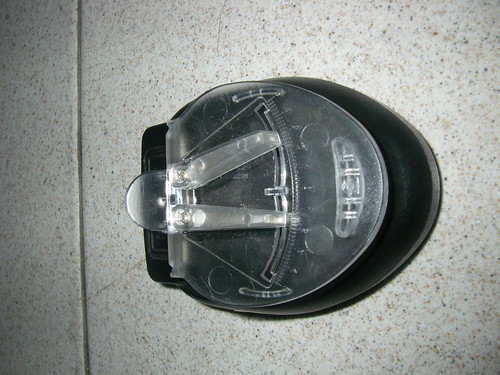
Okay, so we've been seeing a lot of wonderful sites and we are not missing the 9-5 at all, but there has been a downside. We have been afflicted by an amazing run of bad electronics luck. To this point, the following items have mysteriously broken
1. ipod charger
2. camera battery charger
3. ipod (just yesterday)
4. Pocket PC charger
5. New ipod charger 50% of the time (so far)
That's about once every 21 days that something breaks. The upside is that we have been able to find cheep replacements as well as using our friend Kim as a courier for our backup pocket PC charger. Above is the photo of our latest purchase. We are quite proud of the insane ingenuity and crappy construction of this particular object. It is essentially a universal battery charger with 2 flimsy pieces of metal acting as contact points. It looks like it will break if we leave it out in a mild breeze.
Speaking of the Kim's meet up with us, we are hoping that we can meet up with more people from back home as we travel around the world, but in the interest of full disclosure we will probably ask you to carry an extra piece of luggage with soldering irons, copper wire, adapters, etc.
Saigon--Just Walk at a Consistent Pace and Everything Will Be Fine
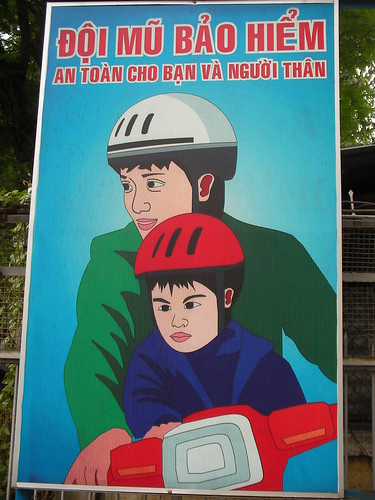 After hearing so much about the bright lights and big city of Saigon, we were really excited to experience it first-hand. We rolled in around 6 pm and were dropped off in the tourist district to find lodging for the night. Within 2 minutes, we were literally dragged off by 2 separate old ladies to look at their guesthouse options. This was pretty distinct from what we'd experienced in the rest of Southeast Asia--and pretty refreshing, although after a few days, I started noticing mysterious finger-sized bruises down my arms.
After hearing so much about the bright lights and big city of Saigon, we were really excited to experience it first-hand. We rolled in around 6 pm and were dropped off in the tourist district to find lodging for the night. Within 2 minutes, we were literally dragged off by 2 separate old ladies to look at their guesthouse options. This was pretty distinct from what we'd experienced in the rest of Southeast Asia--and pretty refreshing, although after a few days, I started noticing mysterious finger-sized bruises down my arms.
We ended up the fourth floor of a guesthouse along one of the busier intersections in District 1, and couldn't resist taking some video of the mesmorizing flow of traffic from our balcony. So many motorbikes, so few accidents. We also had to film a short educational video on how to cross the street in Saigon--always an adventure!
We spent a couple of days wandering around the central city, in search of the best Pho ever (mission accomplished!), and visiting the markets, historical sites, and of course the War Remnants Museum (formerly the Museum of American Aggression). The museum was filled with amazing and sobering photographs from the war and its aftermath. Of course, just walking around the streets, you see this aftermath in amputees and people born with defects from Agent Orange.
Despite this very recent history, the people here are extremely friendly, proud, resilient, and seemingly too busy to think much about the past. Compared with the other Asian cities we've visited, Saigon is definitely the most polished and on-the-move, making it easy to see how Vietnam's economy is one of the fastest-growing in the world.
-K
Labels: Asia, Southeast Asia, Vietnam
Tuesday, January 22, 2008
Phnom Penh
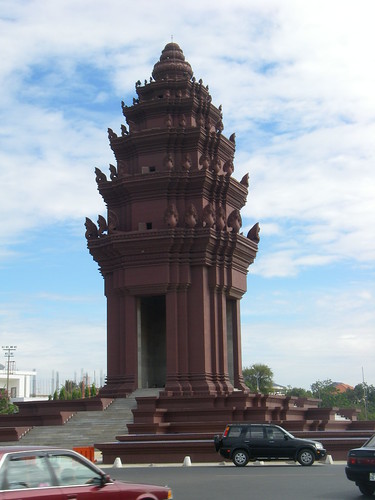 We entered Phnom Penh in perhaps the worst possible way. It was early evening and after the time it took to walk the back streets, it was already dark. As mentioned in earlier posts, Cambodia is still trying to work out the kinks of building/maintaining its cities. In Phnom Penh, that means that on the outskirts of the town, lighting is non existent. So after dropping our bags and setting out, our expectations were quite low. The streets were trash-filled and some of the dark alleys felt a bit sketchy. But, first impressions can be deceiving. By daybreak, the city seemed to start its metamorphosis. Suddenly, the trash seemed to lessen, the parks seemed manicured and the restaurants abundant.
We entered Phnom Penh in perhaps the worst possible way. It was early evening and after the time it took to walk the back streets, it was already dark. As mentioned in earlier posts, Cambodia is still trying to work out the kinks of building/maintaining its cities. In Phnom Penh, that means that on the outskirts of the town, lighting is non existent. So after dropping our bags and setting out, our expectations were quite low. The streets were trash-filled and some of the dark alleys felt a bit sketchy. But, first impressions can be deceiving. By daybreak, the city seemed to start its metamorphosis. Suddenly, the trash seemed to lessen, the parks seemed manicured and the restaurants abundant.
But the city has not been graced with the easiest of histories. On our third day, we decided to visit the heart of the insanity that was the Khmer Rouge regime, namely the Killing Fields at Choeung Ek and the Tuol Sleng, or S-21 prison. In an effort to usher in a demented form of "communism," genocidal Pol Pot and the leaders of the Khmer Rouge decided that it was necessary to torture and kill intellectuals, tradesmen, political opponents, politicians and pretty much anyone else that got in their way. The result was that over 40% of the population of the entire country was tortured and murdered. 40%. And as if that weren't crazy enough, the regime borrowed a page from the Nazi handbook and kept detailed records of all of the people who they felt it necessary to kill.
Our first stop was at the Killing Fields, one of hundreds of places throughout Cambodia where people, from infants, to the elderly where executed. To say that the experience was difficult is a colossal understatement. At the entrance of the site, a bone pagoda sits with the skulls of hundreds of murdered people in levels rising high overhead. Walking around the hastily dug pits where thousands were buried and seeing fragments of bones still embedded in the earth was heartbreaking. As we continued around the site trying our best to keep from crumbling, our tour guide pointed out the butterflies that swarmed all around the burial pits but nowhere else around the site. For Buddhists, this notion of the souls of the tortured and murdered returning to grace the graceless site seemed to offer the closest thing to comfort.
The next site was the infamous S-21 prison. S-21 was one of the Khmer Rouge's central processing points and torture facility. The methods employed were simple: starve, torture and humiliate people until they confessed to a trumped-up charge, and then execute them. What makes the place even more absurdly terrible is that it was a converted high school. The grounds still look like any typical high school anywhere in the world with manicured lawns and a central quad. Inside the campus buildings is the incredibly moving tribute of line after line of photos. Each of the thousands that came through were photographed upon entry or prior to execution. And seeing the faces of children, teenagers, the middle-aged and old and knowing the fate that they endured made it difficult to fathom the horrors that humans can commit.
Unfathomably, many tourists combine a tour of these sites with a stop-off at a nearby shooting range to try their hand at shooting an A-K. Needless to say, we skipped that part. We felt like we needed at least one class in Cold War politics to understand the Khmer Rouge, as well as the current political situation in Cambodia.
And what of a city, no less a country, that endures this kind of hardship? Many of the people who were directly affected by the Khmer Rouge, either as victims or indoctrinated as soldiers and child soldiers are trying to go about their daily lives. But this is the amazing thing, the people are guarded, but wonderfully sweet and open once you get to know them a bit. There is the sense that while the scars that were inflicted from 1975-1979 are still there, the people remain, somehow, hopeful.
While it was hard to leave behind the images and emotions of the Killing Fields and S-21 and return to the world of tourist, we spent the next 3 days exploring the myriad neighborhoods, eating wonderful food and drinking an absurd amount of fruit shakes.
By the end of our five days, Phnom Penh became one of my favorite cities. With a mix of beauty and tragedy, of bustle and sweetness, it is one of the places I could easily imagine living in.
-d
Labels: Asia, Cambodia, Southeast Asia
Sunday, January 20, 2008
Delta Blues and Greens and Browns
 So we bid farewell to Cambodia in the best way possible, namely by taking a slow boat from just outside of Phnom Penh to Chau Doc on the Vietnamese portion of the Mekong Delta. After an absurdly fast and dangerous 45 minute bus ride, short-cutting the construction on the main road and flying down dirt roads through tiny villages to the boat dock--we boarded the first boat that would carry us to the Vietnamese border. On this leg, the shores were uncluttered, the water clean and the scenery beautiful. As the boatfull of people were just drifting into a deep trance, we pulled up to the Vietnamese border.
So we bid farewell to Cambodia in the best way possible, namely by taking a slow boat from just outside of Phnom Penh to Chau Doc on the Vietnamese portion of the Mekong Delta. After an absurdly fast and dangerous 45 minute bus ride, short-cutting the construction on the main road and flying down dirt roads through tiny villages to the boat dock--we boarded the first boat that would carry us to the Vietnamese border. On this leg, the shores were uncluttered, the water clean and the scenery beautiful. As the boatfull of people were just drifting into a deep trance, we pulled up to the Vietnamese border.
Again, I wondered if the experience of crossing the border would be a hint of the culture to come. In short, we hope not. At the border we were ushered to the "health check." The health check consists of a man accepting $2,000 dong (about 16 cents) and letting you leave. I think it might have been a healthy wallet check, not sure, but we did receive an official looking stamp for our troubles. Next, we were ushered to a nearby resteraunt to wait for the border officials to review our passports and visas. Strangely, the time it took to complete the task was exactly how long it took for the only restaurant at the border to serve travelers lunch and collect the checks. It was made clear that ordering was not optional.
Anyhoo, when we finally crossed the border on our second slow boat and began our float down the Vietnamese leg of the river into the delta, the idea of a border became abundantly clear. Suddenly, there were houses stacked close together, there were small and medium scale industries spaced between houses, and the river was full of all forms of vessels cruising in what appeared at times a haphazard pattern. We docked that night in Chau Doc and had a fun and final evening out with our friend Kim before she headed back to Chicago via Saigon.
Day two we took the boat to Can Tho by way of a few floating markets, monkey bridges (rickety bamboo river crossings), a rice noodle cottage operation and a rice processing plant. The floating market saw our first true failure in the art of bargaining. Apparently, mango prices are much more firm than that of nock-off designer wear. Lesson learned. The monkey bridge was a bit underwhelming after the truly rickety bridges of Laos, but the walk along the banks gave us a different view of the river that we had been floating on for the past two days. As for the factories, they were extremely interesting, and they certainly seemed to fall more than a hair's breath short of OSHA standards.
With the completion of the slow boat trip, we were herded onto buses for our next stop: Saigon.
-d
Labels: Asia, Southeast Asia, Vietnam
Monday, January 14, 2008
Battambang
 Although Battambang is the second largest city in Cambodia, it masquerades as a sleepy town along a river in western Cambodia; just the sort of place to relax after a couple of days of intense tourist activity. The place doesn't get many tourists, so we found that people were really friendly and genuinely interested in what you were doing in their town. They're also interested in practicing their English skills with you. Maybe the most unusual person we met this way was a moped driver who frequented our guest house, whose self-proclaimed claim to fame was he was the only driver in Battambang that knew American slang. What this actually meant was that he only communicated in barely intelligible, rapid-fire strings of expressions. Here's a bit of sample conversation: "You know the yellow-bellied, green-eyed monster with bird legs? He's got two left feet, but taste my cabbage, you see the stars."
Although Battambang is the second largest city in Cambodia, it masquerades as a sleepy town along a river in western Cambodia; just the sort of place to relax after a couple of days of intense tourist activity. The place doesn't get many tourists, so we found that people were really friendly and genuinely interested in what you were doing in their town. They're also interested in practicing their English skills with you. Maybe the most unusual person we met this way was a moped driver who frequented our guest house, whose self-proclaimed claim to fame was he was the only driver in Battambang that knew American slang. What this actually meant was that he only communicated in barely intelligible, rapid-fire strings of expressions. Here's a bit of sample conversation: "You know the yellow-bellied, green-eyed monster with bird legs? He's got two left feet, but taste my cabbage, you see the stars."
Exactly!
-K
Labels: Asia, Cambodia, Southeast Asia
Saturday, January 12, 2008
Don't Fear the Siem Reaper
 So we entered Cambodia to the raucous laughter of 10 uniformed immigration officials. We weren't sure what was funny, but it was a heck of a way to be introduced to a country. Our next surprise was that our friend Kim (AKA the Oregon Smasher) decided to pop over from Vietnam and travel with us for the duration of our Cambodia time. Though the logistics of our meet up weren't completely settled on, seeing her pull up on the back of a moped, frazzled and briefly not recognizing us made it seem like we had planned it perfectly. We spent the evening enjoying cheap eats and planning our trip to nearby Angkor Wat.
So we entered Cambodia to the raucous laughter of 10 uniformed immigration officials. We weren't sure what was funny, but it was a heck of a way to be introduced to a country. Our next surprise was that our friend Kim (AKA the Oregon Smasher) decided to pop over from Vietnam and travel with us for the duration of our Cambodia time. Though the logistics of our meet up weren't completely settled on, seeing her pull up on the back of a moped, frazzled and briefly not recognizing us made it seem like we had planned it perfectly. We spent the evening enjoying cheap eats and planning our trip to nearby Angkor Wat.
But first, a brief note about the town of Siem Reap. After the languid rhythm of Laos, the city is a bit of a shock. With the UNESCO World Heritage draw of Angkor nearby, the place is a boomtown. But in the context of Cambodia, a boomtown tends to mean massive construction of luxury hotels without paying any mind to city planning and infrastructure like garbage pickup, or paving roads. The result is that the town feels a bit schizophrenic. It is vibrant and dirty, chaotic and filled with tourists.
On to Angkor. We decided to get the three day pass because our research made clear that one day was nowhere near enough. But with all of the research came the usual anxiety: everyone raves about Angkor Wat and we worried that we would be underwhelmed. There was not reason to be concerned. The place is amazing. Representing 400 years of Khmer culture, the ruins are a massive conglomeration of buildings filled with intricate bas relief carvings seemingly on every surface. What we hadn't fully comprehended was the scale of the entire area. Structures are spread out over a 20 KM square area whose organization, some believed, was an early representation of the universe. What that meant for us was that we had to hire a tuk tuk for each day just to get around.
Someone somewhere along our travels recommended we do the smaller structures first, working our way to Angkor Wat. We spent the first day exploring the outlying structures northeast of the main Angkor Wat and Angkor Thom central complexes. Our first and possibly favorite stop was at Preah Kahn, an enormous and intricate labyrinth of buildings that combined well preserved carvings with complete ruin. It's hard to really describe the experience of seeing all of these sites, other than to say the buildings all combine Hindu and Buddhist iconography, but are all unique, and climbing unbelievably steep stone stairs and scrambling over ruins results in a sweaty sweaty day. (And at some point we'll get around to uploading all those photos).
By the time we got to the actual structure of Angkor Wat on the second day, we were still amazed. We decided to stay into the evening to watch sunset from a hilltop temple, along with about 1,000 other people, which turned into a fun people watching opportunity and pretty great sunset.
-K & D
Labels: Asia, Cambodia, Southeast Asia
Wednesday, January 9, 2008
Vientiane, Paris-ish on the Mekong / Goodbye Laos
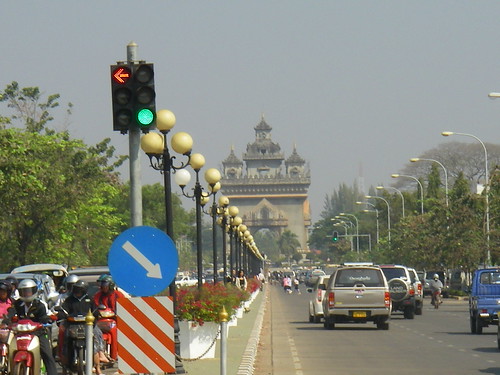 First things first, Laos has gained most favored nation status for us here at Sophisticated Alpaca. We have loved the people and landscape of this nation and are a little heartbroken to leave it. But, as Kristi pointed out, we do have a bunch of places to go and who knows, there may be place we love just as much. If so, we are in for a bucket-full of awesome!
First things first, Laos has gained most favored nation status for us here at Sophisticated Alpaca. We have loved the people and landscape of this nation and are a little heartbroken to leave it. But, as Kristi pointed out, we do have a bunch of places to go and who knows, there may be place we love just as much. If so, we are in for a bucket-full of awesome!
Our final day was spent in the Laos Capitol of Vientiane. The first thing that we noticed about the city is its wide, Parisian-style boulevards and the preponderance of French Colonial architecture. There's a reason for this; they were a French colony once. After the 9 days we had spent in northern Laos, the site of a replica of the Arc de Triumph at the end of a 6 lane street was a bit surreal.
We spent the first evening enjoying a wonderful dinner in an outdoor cafe on the banks of the Mekong. The lights of Thailand across the river reflected in the river and we spent a bit longer than we usually do renting out our particular dining table.
The following day we walked the streets of the main city, realizing quite quickly that, much like the rest of Laos, the population is quite small. The entire country has only 6 million people, so I suppose the scale of the city isn't a surprise. All in all, it was a relaxing way to say goodbye to Laos.
-d
Labels: Asia, Laos, Southeast Asia
Monday, January 7, 2008
Luang Prabang
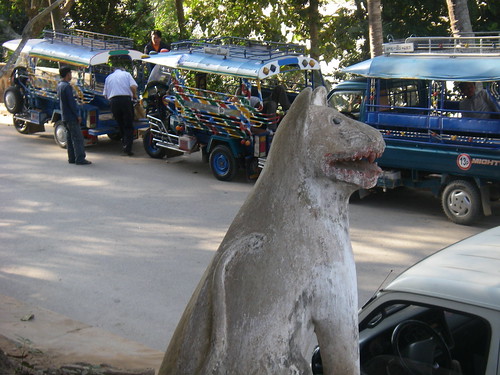 After our wonderful time in Luang Nam Tha, we convinced Paula that the best way to get to the northeast of Laos was to head directly south to Luang Prabang with us. Luckily for the three of us, all the seats on the local bus were sold out. Luckily, the aisle seating wasn't. Luckily, there were plenty of bags of rice in the aisle for us to sit on, and luckily the 9 hour bus ride was filled with hair-pin turns that toppled our seats/ sacks of rice over. Luckily, we have a sense of humor.
After our wonderful time in Luang Nam Tha, we convinced Paula that the best way to get to the northeast of Laos was to head directly south to Luang Prabang with us. Luckily for the three of us, all the seats on the local bus were sold out. Luckily, the aisle seating wasn't. Luckily, there were plenty of bags of rice in the aisle for us to sit on, and luckily the 9 hour bus ride was filled with hair-pin turns that toppled our seats/ sacks of rice over. Luckily, we have a sense of humor.
After scoring a cheap guesthouse due to Paula's remarkable Lao language charms, we set out for a walk around the night market. The previous days of activities and the early morning bus ride left us a little zombie-like, but we were able to stitch together a good meal out of small bags of street food.
After some more wondering, we ran into Patrick and Greg, a couple of Quebequois that were on our bus and decided to crash their table. Upon hearing of Kristi's allergy to beer, Greg launched into a scathing attack on the way that restaurants in southeast Asia take care of their wine. It seems that leaving wine in the front window in 35 degree Celcius temperatures turns wine into vinegar. Which is bad. But luckily, Greg gave us a good 10 part recipe for a salad dressing if we ever do get a bottle of Asian-styled French wine. The rest of the night was spent trading stories and talking films, novels, and politics.
The following day, Kristi and I walked the small town of Luang Prabang, which has been designated a UNESCO world heritage site. The city is full of strange hybrid architecture which combines Khmer, Lao, Burmese, and French colonial influences.
After meeting up with Greg and Paula, we continued our rambling conversation until the Laos government designated business closing hour of 11:30 pm. Of note, there is a not-so-secret secret bowling alley in the city that does stay open till 4 am, but our next morning's 6 am departure discouraged us. Maybe next time.
So as we bid goodbye to Paula and Greg, we confirmed that our return trip across the U.S. and Canada may now end in Greg's small but happenin' hometown in Quebec. And Greg, if you're reading this, we expect to be greeted in the manner of an Italian grandmother--with fine wine, 14 cheeses, and a cabin by the lake! Oh la la, we could have spent a few more days here--damn our schedule.
-d
Labels: Asia, Laos, Southeast Asia
Saturday, January 5, 2008
Three Days in the 'Nam Tha with a Tazmanian Devil
 One of the now habitual things about this trip is the tendency to change plans. But arriving in Luang Nam Tha, Laos was the culmination of about six different changes. We couldn't decide whether to do a slow-boat trip down the Mekong or head into Northern Lao near the Chinese border. For days we went back and forth until our Scottish-and slightly inebriated- guest house owner in Chang Mai told us that we should float the Mekong further south and go to Northern Laos. Sometimes it just takes a little nudge.
One of the now habitual things about this trip is the tendency to change plans. But arriving in Luang Nam Tha, Laos was the culmination of about six different changes. We couldn't decide whether to do a slow-boat trip down the Mekong or head into Northern Lao near the Chinese border. For days we went back and forth until our Scottish-and slightly inebriated- guest house owner in Chang Mai told us that we should float the Mekong further south and go to Northern Laos. Sometimes it just takes a little nudge.
After our rocking New Years, we hopped a bus to Luang Nam Tha where we met Paula, an Tazmanian (not an Aussie) with a wonderful ability to pick up useful pieces of the Lao language: Examples such as "I love you, do you love me?," "I don't eat meat, I only eat tuk tuks," and "You insult me, that price is too high." So we didn't get to use the first two, but the last one comes in quite handy. After a fun bus trip chatting about our travels and being welcomed at a roadside bus stop by a group of old Lao men encouraging us to take a drink of their home-brewed Lau Lau (rice whiskey, many claim), we walked the small town of Luang Nam Tha in search of a place to sleep. We ended up looking at 6-7 different places and thankfully ending up at the single best place we have stayed since we left the US. A series of small bungalows (with hot-ish showers!) and a great little restaurant made the packing around town well worth it. The manger of the guest house, Tuey, welcomed us so warmly and talked into the night with Kristi, Paula and I. It was great to get some insight into the country, to just swap stories, and learn a few new "useful" phrases.
The next morning we set out to book a low-impact eco tour in the Nam Tha National Protected Area and bike the surrounding areas. The biking was incredible and included a visit to a stupa that had been bombed in World War 2 "staffed" by a group of firecracker-wielding, chain-smoking kids demanding a fee for visiting. Their numbers and weaponry made us relent--leaving us out about 9 cents. Spend wisely, you little hooligans. After the stupa we rode through rivers and up hills a little too steep to complete and also failed in an attempt to visit a waterfall that was either 2 km or 12 km outside of town. But a days biking was just the warm up...
We awoke early the next day to do our trek--a little sore from biking, but ready. Our guide, Pon, explained that day one would be about 6 hours of hiking to get to the Akha Hill tribe's village where we would be staying. He outlined the hike by saying that it was a little uphill and a little downhill. I spent the day gawking at the amazing scenery and wondering when the downhill parts were coming. Pon lied to us. But he and the other two guides made up for it by preparing an amazing lunch--which would be followed by 4 more fantastic meals including our first taste of Rattan Soup, and Banana Flower, both collected in the forest as we trekked). If the guide thing doesn't work out, the three of them could definitely make a mint with a restaurant!
Even still, the work was worth it. When we reached the hill tribe we were greeted by a bunch of the village children yelling the one Lao word that they all know, "Sabade." Nothing like having 20 kids yelling hello at you at the end of a hike. Once we settled in, we did a tour of the village and were invited into a family's home for a ceremonial meal. The experience was incredibly moving and the food amazing. After meeting the chief and being asked to partake in a few "samples" of the local rice whiskey/rotgut Lau Lau we were easily able to sleep for the night.
Pon woke us early with a quick breakdown of our 2nd day hike. He promised that there was only one small hill and the rest was more rolling forest lands. I didn't believe him. But it seemed he wanted to redeem himself. The hike was a bit easier and took us through hardwood forests at the ridge-line, tropical forests filled with bamboo stands and finally rice paddies. The hike was also not as filled with narrow-logged bridges called (by Pon) "dancing bridges" for their tendency to be very unstable. With the exception of smelling a little ripe, the three of us returned to our home-away-from-home quite happy.
-d
Labels: Asia, Laos, Southeast Asia
